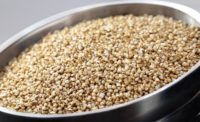
Maximizing the Benefits of Whole Grains
By Ann Przybyla Wilkes, SFA VP of Communications
The release of the 2005 Dietary Guidelines for Americans increased consumers’ awareness of the importance of incorporating whole grains in their diet. Yet, the majority of consumers do not understand what the specific health benefits are or how they may personally benefit from whole grains.
Although health professionals and researchers have a better grasp of many of the health benefits derived from consuming whole grains, they also have many questions on specific benefits. One reason for this is that prior to the recent emphasis on whole grains, much of the research focused on the benefits from bran alone.
Leading scientists, educators, food industry representatives and policymakers in this field recently gathered from around the world in Minneapolis to assess the current knowledge about whole grains and their health benefits, identify where knowledge gaps are, and make recommendations for research and education. Whole Grains & Health: A Global Summit, held May 18-20, 2005, was sponsored by the University of Minnesota.
Current Status
Many people do not have an accurate understanding of what “whole-grain” means, suggested Steve Sanger, chairman of the board and CEO of General Mills, Inc. Research by General Mills has found that three out of four consumers say they are consuming the recommended amount of whole grains, yet only one in 10 actually is.
In studies conducted in the United Kingdom, Chris Seal, University of Newcastle upon Tyne, UK, found that many people couldn’t correctly identify whole-grain foods. Some incorrect answers included brown bread, all bran, bran cereal, wild rice and brown pasta. He stressed that consumers need to be educated about how to find and identify whole-grain foods, in addition to what the health benefits are.
The food industry needs to produce more variety and better quality whole-grain products, Seal recommended. However, he cautioned that consumers don’t like to be told to change. He suggested that a better terminology is “improvement,” or “make more healthy,” when introducing whole-grain foods to consumers.
Whole-grain intake in the United States is far below recommended levels, Linda Cleveland, U.S. Department of Agriculture (USDA), Food Surveys Research Group, said. Only 7% of Americans meet the 2005 Dietary Guidelines suggestion to eat three or more servings of whole grains every day, and less than 5% consume at least half of their servings from whole-grain sources. The average intake of whole grains in the U.S. is less than one serving per day, and those most likely to eat whole grains are female, older, white, higher income and higher educated people.
Educating Consumers
One way consumers are learning about the importance of whole grains in their diet is through the Web site, MyPyramid.gov. Joan Lion, USDA, Center for Nutrition Policy and Promotion, told summit attendees that there were 400 million hits to MyPyramid.gov as of the middle of May. The site received 100 million hits the first week it was on the Web. USDA had expected five million hits that week.
Lion explained that USDA will promote whole grains in the context of an overall healthy diet. In addition, USDA will release a children’s pyramid by late summer that will have interactive material for grade school teachers and will be more fun.
The food industry also is playing an active role in educating consumers about the benefits of whole grains. General Mills, for example, makes more than 5,000 consumer contacts a day. When the company issued a press release in September 2004 announcing that it would make all of its cereals with whole grains and subsequently launched a Web site — wholegrainlife.com — as part of a three-day Internet blitz, 1.4 billion media impressions, which reached 95% of Americans, resulted.
A cereal box is one of the most read items in American households, Sanger said. To take advantage of that, General Mills has partnered with USDA to have 100 million cereal boxes with information about MyPyramid.gov on store shelves by late summer. General Mills’ whole-grain initiative adds 1.5 billion whole-grain servings for Americans each year, and 26 million servings of whole grains per day.
Increasing Consumer Acceptance
Horizon Milling, a Cargill Foods affiliate, introduced GrainWise Wheat Aleurone at the Whole Grains Summit. A wheat grain consists of 2.5% germ, 15-25% bran, and 75-80% endosperm. Aleurone is an all-natural ingredient derived from the aleurone layer of the wheat kernel and contains antioxidants and pytochemicals, in addition to fiber.
Since Aleurone has less pigment and flavor, it can be incorporated into foods at higher levels than full bran. Snack foods are one of the possible applications for Aleurone, which can replace 20% of white flour. Possible labeling on an ingredient statement includes wheat extract, wheat fiber, wheat fraction or wheat aleurone.
Kim Snow, of Cargill, Inc., spoke at the summit on marketing whole-grain products and Aleurone. She identified growth drivers of whole-grain products as media attention, U.S. Food & Drug Administration (FDA) approval of a whole-grain health claim, public awareness of benefits of whole grains and new product development in this area.
A major barrier to increased consumption of whole-grain products is information overload. In an online survey of 2,400 consumers, conducted by Cargill in March 2004, 60% of consumers said there is too much conflicting information concerning whole grains. In addition, 30% said that this confusion leads to unhealthy diet. The survey also found that cost is a barrier to increased consumption of whole-grain products, with 34% of the participants stating that healthy foods cost more.
Of the new food products introduced worldwide between May 2004 and April 2005 that listed whole grains as primary ingredient, 33% were breakfast cereals, 30% bakery products, 24% snacks, 6% meals, 3% side dishes, 1% desserts, 1% meat and eggs, and 2% were other products, reported Snow.
What is Needed
Consumption of whole grains offers numerous health benefits, including protection against coronary heart disease (CHD) and certain types of cancer, a reduced risk for developing diabetes, and improved weight management. However, questions remain. It is unknown as to why some cancers are more affected by whole grains than other, or what components of whole grains protect against CHD, to name a few.
“Despite the long-held belief that whole-grain products provide a health benefit, the specific contributions that whole grains provide to the healthy diet have been under-explored. A better understanding is needed as to how processing affects the physical interactions of these components within the food,” Gary Fulcher, professor and head of the Department of Food Science, University of Manitoba, told attendees.
Many of the speakers expressed a need for randomized, clinical trials to learn more about the health benefits of whole grains. One problem with current knowledge is that much of what is known is based on epidemiological studies. Since higher whole-grain consumption is associated with higher intake of fruit, vegetables, reduced low fat, milk, yogurt and oily fish (all of which provide additional health benefits), it is difficult to isolate the specific health benefits from whole grains. In addition, clinical studies could help determine if health benefits attributed to whole grains are realized from all sources of whole grains or only specific ones.
The need to define “whole grain” also was addressed by several of the speakers at the summit. Lester M. Crawford, acting commissioner of the FDA, told attendees that the agency has the following priorities:
Initiate rulemaking on label claims for whole grains.
Define the term, “whole-grain.”
Define “good source” and “excellent source” of whole grains.
Define the term, “whole-grain.”
Define “good source” and “excellent source” of whole grains.
Not everyone thinks FDA is acting quickly enough. The Grain Foods Foundation (GFF) is petitioning FDA to move these priorities from its “B list” to “A list” of annual priorities, in light of the strong support of whole grains from the 2005 Dietary Guidelines for Americans and Healthy People 2010, GFF president Judi Adams told participants.
General Mills’ Sanger summed up how to maximize the health benefits of whole grains:
Consumers must become more aware.
Scientists must advance research.
Educators must make whole grains relevant.
Policy makers must set high nutritional standards and make clear requirements.
Food marketers must clearly communicate benefits on packaging and in advertising.
Consumers must become more aware.
Scientists must advance research.
Educators must make whole grains relevant.
Policy makers must set high nutritional standards and make clear requirements.
Food marketers must clearly communicate benefits on packaging and in advertising.





